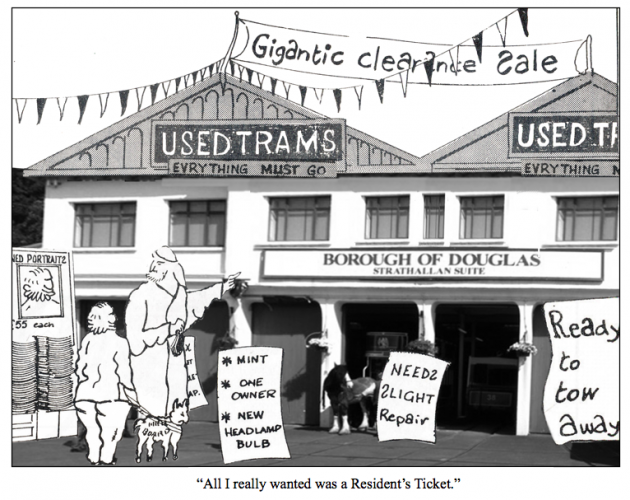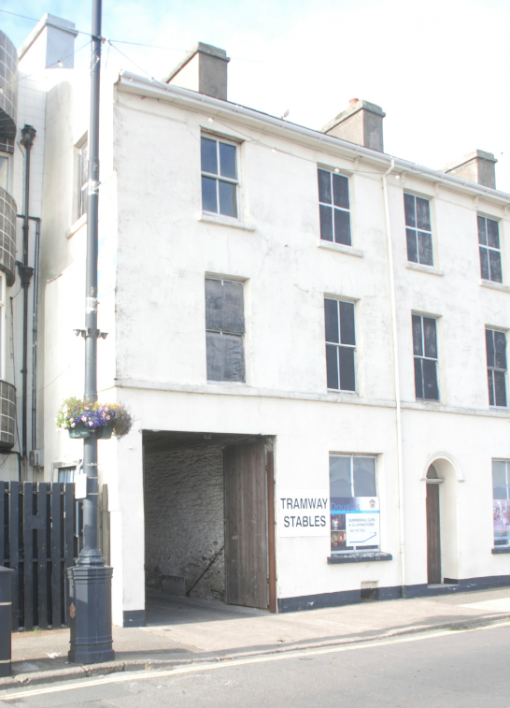PRESS RELEASE FROM THE MANX ELECTRIC RAILWAY SOCIETY
_______________________________
DOUGLAS HORSE TRAMWAY
TRAM SALE PROPOSAL
_______________________________
1. At some point last Thursday, the day before the dissolution of Tynwald, a press release on behalf of Douglas Borough Council announced the sale of six Douglas horse trams by auction. The auction is to occur very swiftly. The auction will occur on 27.08.16 at 10:00. The trams if purchased will need to be removed by 30.09.16. There appears to be an element of indecent haste here.
2. This has been described by Councillor Pitts as being done to “assist” the Department of Infrastructure (the Department of the Manx Government which has taken over the line) “in consolidating its core horse tram stock”…
3. Behind this move is the murky world of Manx politics;
3.1. Last year Douglas Borough Council announced its intention to discontinue services on the Douglas Bay Horse Tramway which with the exception of time of war has operated continuously since 1876. Mr Phil Gawne, the Minister for the Department of Infrastructure stepped in and announced that he was the Champion of the Horse Tramways and that he would do all he could to save the line.
3.2. Negotiations took place between the Department and Douglas Council and it was agreed that the tramway would be transferred to the Department for a three year period.
3.3. The Department is responsible for road building and maintenance and an application swiftly followed in the name of the Champion of the Horse Tramway, for planning permission to lift the line and not replace it between the Sea Terminal and the War Memorial (roughly half the length).
3.4. The Friends of the Douglas Bay Horse Tramway announced that this was the best chance of keeping the horse tramway and sought to co-operate with the Department in the proposed re-vamp of the system.
3.5. The Manx Electric Railway Society understood that this was a political issue and vociferously opposed the planning application and the Minister in seeking to cut back the line.
3.6. This summer as a result of that vociferous opposition, Tynwald voted to retain the full length of the tramway. The Department withdrew its planning application.
4. What was not clear at the time of the take-over was that the transfer did not involve all of the trams and did not involve all of the property.
4.1. The Council retains the horse tramway stables. This is a charming, ancient building which someone wants to turn into “Stables Apartments”. The Council sees this not as a potential tourist asset but as an opportunity for Development.
4.2. So how can the Department run the tramway without stables? It cannot do so, so it needs another place to put them. Hence the decision to sell off horse trams which presently reside in the Strathallan horse tram depot at the Derby Castle end of the line and to use the space to develop a horse stables.
4.3. The Council is not helping the Department to consolidate its rolling stock, it is helping itself to a public asset; the stables. And it is doing the dirty work of disposal of trams for the Department.
5. It is interesting to note that both the stables and the Strathallan Depot fall within the Douglas Promenades Conservation area, and development at either site will require grant of planning permission. The haste in getting rid of the trams must be motivated by something other than the need to clear the stables site for this cannot occur without planning consent.
6. Douglas Borough Council can rest assured that the Manx Electric Railway Society, which has since its inception fought for the preservation of the horse tramway as well as the MER will do all it can to oppose applications for development at either site which involve removal of the stables from where they have been for over 100 years.
7. As a sop to public concern the prospective purchasers will be asked to sign a statement of intent that “the undersigned will take responsibility for the horse tram carriage as described in this document ‘as seen’ and agrees to preserve the tram.” This “statement” is no more than a statement of intention at the time it is signed. It is not under seal and not for consideration and it is un-enforceable. The signatory can change his mind and break up the bodies if he wishes. To remove the remains (or the trams as a whole) from the Island may fall foul of Manx legislation however. But it may not. It certainly did not save No. 46 (see below).
8. Those who seek to remove these trams from the Isle of Man should know that the Manx Electric Railway Society will do all it can to use the full force of Manx law to keep them here.
9. The trams to be got rid of are;
9.1. No. 28 a winter saloon built by George Milnes in 1892. This tram was built the year before George Milnes built Car No. 1 on the Manx Electric Railway and is in itself an important piece of Manx industrial archaeology.
9.2. No. 33 an 1896 Milnes Bulkhead Toast Rack.
9.3. No. 34 an 1896 Milnes Bulkhead Toast Rack.
9.4. No. 37 an 1896 Milnes Bulkhead Toast Rack.
9.5. No. 39 a 1902 Milnes Open Toast Rack.
9.6. No. 40 a 1902 Milnes Open Toast Rack.
10. It is conceded by Douglas Council that each of the trams is capable of restoration. They form part of the only surviving substantial collection in the world of Milnes Horse trams and are, as a collection, of priceless importance to the Isle of Man and its industrial archaeology and heritage in general.
11. Douglas Council is effectively saying that it can be trusted in the disposal of these unique, priceless, iconic Manx artefacts. Yet a close scrutiny of the record of Douglas Council with regard to its wonderful horse trams is a sorry one;
11.1. An example of an earlier sale for preservation was No. 46 of 1909, left in the open at Nobles Park but sold to the UK and broken up.
11.2. Not for sale is No. 11 (built in 1886), the oldest surviving horse tram built for the Isle of Man. It is still owned by Douglas Council and has been left dumped in the open behind a Museum in Jurby for years. Is this the measure of “agrees to preserve the tram” required in their statement of intent.
11.3. Not for sale is No. 47 of 1911 dumped in the same place.
12. There is only one survivor left in the World of all of the horse tramways that ran in the 19th Century. In the view of the Manx Electric Railway Society it would be an act of folly for Douglas Borough Council to give others the opportunity to undermine such a unique asset. And all at a time when tourism may be of pivotal importance to the survival of the Island.
13. Cumulatively, more than 700 years of history is for sale for the short term benefit the ratepayers of Douglas. The MERS is concerned that purchasers may only want the trams for their running gear or the scrap. We call upon all right thinking people to support us in opposing this sale. If the sale goes ahead it makes it easier to demolish the stables and ruin the depot and the sale should therefore be boycotted.
What do you think ? Please let the MERS know, send your comments to [email protected]

